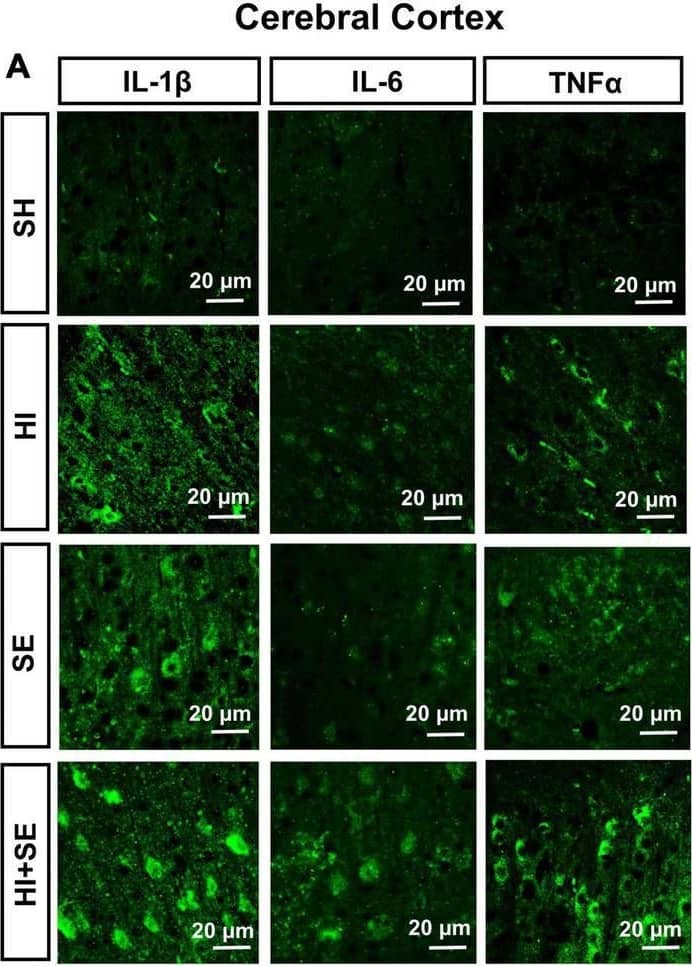Mouse TNF-alpha Antibody Summary
Applications
Please Note: Optimal dilutions should be determined by each laboratory for each application. General Protocols are available in the Technical Information section on our website.
Scientific Data
 View Larger
View Larger
Detection of Recombinant Mouse, and Rat TNF‑ alpha by Western Blot. Western blot shows 25 ng of Recombinant Mouse TNF-a aa 80-235 (Catalog # 410-MT), Recombinant Human TNF-a (Catalog # 210-TA), Recombinant Rat TNF-a (Catalog # 510-RT) and Recombinant Mouse Lymphotoxin- a/TNF- beta. PVDF Membrane was probed with 1 µg/mL of Hamster Anti-Mouse TNF-a Monoclonal Antibody (Catalog # MAB410) followed by HRP-conjugated Anti-Hamster IgG Secondary Antibody. A specific band was detected for TNF-a at approximately 15 kDa (as indicated). This experiment was conducted under reducing and non reducing conditions using Immunoblot Buffer Group 3.
 View Larger
View Larger
Detection of Mouse TNF-alpha by Immunohistochemistry Inflammatory response induced by HI injury and maternal SE. Representative images of immunofluorescence staining of inflammatory cytokines IL-1 beta, IL-6, and TNF alpha in the cerebral cortex (A) and the hippocampus (E). The immunofluorescence intensity of IL-1 beta (B,F), IL-6 (C,G), and TNF alpha (D,H) in the cerebral cortex and hippocampus. Results are presented as mean ± SEM. *P < 0.05, **P < 0.01, n = 4, analyzed by two-way ANOVA followed by post hoc Turkey tests. SH, from sham exposed dams with sham surgery; HI, hypoxic-ischemic injury; SE, from smoke exposed dams with sham surgery; HI + SE, from smoke exposed dams with hypoxic-ischemic injury. Image collected and cropped by CiteAb from the following publication (https://pubmed.ncbi.nlm.nih.gov/35250486), licensed under a CC-BY license. Not internally tested by R&D Systems.
Preparation and Storage
- 12 months from date of receipt, -20 to -70 °C as supplied.
- 1 month, 2 to 8 °C under sterile conditions after reconstitution.
- 6 months, -20 to -70 °C under sterile conditions after reconstitution.
Background: TNF-alpha
Tumor necrosis factor alpha (TNF-alpha, TNF- alpha, TNFA ), also known as Cachectin and TNFSF2, is the prototypic ligand of the TNF superfamily. It is a pleiotropic molecule that plays a central role in inflammation, immune system development, apoptosis, and lipid metabolism. TNF-alpha is produced by several lymphoid cells as well as by astrocytes, endothelial cells, and smooth muscle cells. Mouse TNF-alpha consists of a 35 amino acid (aa) cytoplasmic domain, a 21 aa transmembrane segment, and a 179 aa extracellular domain (ECD). Within the ECD, mouse TNF-alpha shares 94% aa sequence identity with rat and 70%-77% with bovine, canine, cotton rat, equine, feline, human, porcine, and rhesus TNF-alpha. TNF-alpha is produced by a wide variety of immune, epithelial, endothelial, and tumor cells. TNF-alpha is assembled intracellularly to form a noncovalently linked homotrimer which is expressed on the cell surface. Cell surface TNF-alpha can induce the lysis of neighboring tumor cells and virus infected cells, and it can generate its own downstream cell signaling following ligation by soluble TNFR I. Shedding of membrane bound TNF-alpha by TACE/ADAM17 releases the bioactive cytokine, a 55 kDa molecular weight soluble trimer of the TNF-alpha extracellular domain. TNF-alpha binds the ubiquitous 55-60 kDa TNF RI and the hematopoietic cell-restricted 80 kDa TNF RII, both of which are also expressed as homotrimers present on virtually all cell types. Both type I and type II receptors bind TNF-alpha with comparable affinity, although only TNF RI contains a cytoplasmic death domain which triggers the activation of apoptosis. Soluble forms of both types of receptors are released and can neutralize the biological activity of TNF-alpha.
Product Datasheets
Citations for Mouse TNF-alpha Antibody
R&D Systems personnel manually curate a database that contains references using R&D Systems products. The data collected includes not only links to publications in PubMed, but also provides information about sample types, species, and experimental conditions.
7
Citations: Showing 1 - 7
Filter your results:
Filter by:
-
The brighter (and evolutionarily older) face of the metabolic syndrome: evidence from Trypanosoma cruzi infection in CD-1 mice
Authors: Wunnie Brima, Daniel J. Eden, Syed Faizan Mehdi, Michelle Bravo, Mohammad M. Wiese, Joanna Stein et al.
Diabetes/Metabolism Research and Reviews
-
Amelioration of systemic fibrosis in mice by angiotensin II receptor blockade.
Authors: Marut W, Kavian N, Servettaz A, Hua-Huy T, Nicco C, Chereau C, Weill B, Dinh-Xuan A, Batteux F
Arthritis Rheum, 2013-05-01;65(5):1367-77.
Species: Mouse
Sample Types: Whole Cells
Applications: Western Blot -
Mutual modulation between interleukin-10 and interleukin-6 induced by Rhodococcus aurantiacus infection in mice.
Authors: Yimin, Kohanawa M, Ozaki M, Haga S, Fujikawa K, Zhao S, Kuge Y, Tamaki N
Microbes Infect., 2008-09-13;10(14):1450-8.
Species: Mouse
Sample Types: In Vivo, Whole Cells
Applications: Neutralization -
Role of Valpha14+ NKT cells in the development of Hepatitis B virus-specific CTL: activation of Valpha14+ NKT cells promotes the breakage of CTL tolerance.
Authors: Ito H, Ando K, Ishikawa T
Int. Immunol., 2008-05-16;20(7):869-79.
Species: Mouse
Sample Types: In Vivo
Applications: Neutralization -
TNFalpha and TNF receptor 1 expression in the mixed neuronal-glial cultures of hippocampal dentate gyrus exposed to glutamate or trimethyltin.
Authors: Figiel I, Dzwonek K
Brain Res., 2006-12-11;1131(1):17-28.
Species: Rat
Sample Types: Cell Lysates
Applications: Western Blot -
Maternal Cigarette Smoke Exposure Exaggerates the Behavioral Defects and Neuronal Loss Caused by Hypoxic-Ischemic Brain Injury in Female Offspring
Authors: Taida Huang, Xiaomin Huang, Hui Li, Junhua Qi, Nan Wang, Yi Xu et al.
Frontiers in Cellular Neuroscience
-
A microwell-based impedance sensor on an insertable microneedle for real-time in vivo cytokine detection
Authors: Naixin Song, Pengfei Xie, Wen Shen, Hanju Oh, Yejia Zhang, Flavia Vitale et al.
Microsystems & Nanoengineering
FAQs
No product specific FAQs exist for this product, however you may
View all Antibody FAQsReviews for Mouse TNF-alpha Antibody
There are currently no reviews for this product. Be the first to review Mouse TNF-alpha Antibody and earn rewards!
Have you used Mouse TNF-alpha Antibody?
Submit a review and receive an Amazon gift card.
$25/€18/£15/$25CAN/¥75 Yuan/¥2500 Yen for a review with an image
$10/€7/£6/$10 CAD/¥70 Yuan/¥1110 Yen for a review without an image












